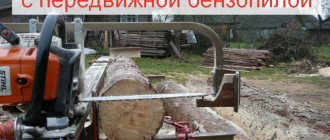A chainsaw is a worthy replacement for hand saws and axes. Today, this tool is available in almost every household - it is indispensable when arranging a personal plot, construction and repair work. Intensive use and improper care of the tool can lead to premature failure. However, it is not at all necessary for the owner of a chainsaw to immediately contact a workshop - many of the malfunctions that can happen to it during operation can be easily eliminated on their own.
- 2 Starting the engine: checking the spark plugs
- 3 Do-it-yourself chainsaw repair: fuel supply system
- 4 Troubleshooting muffler problems
- 5 Repair of the cylinder-piston group (CPG)
- 6 Checking the carburetor and signs that it needs adjustment
- 7 Calibration algorithm and safety precautions when troubleshooting a chainsaw carburetor
- 8 Other malfunctions of chainsaws
- 9 DIY chainsaw repair, video
Chainsaw design
To carry out repairs correctly, you need to understand the design of the unit. A chainsaw consists of several main components:
- Gas engine;
- Carburetor;
- Air filter;
- Starter;
- Saw bar and chain.
Most models have a two-stroke single-cylinder gasoline engine. Fuel is supplied to the CPG chamber (cylinder-piston group) via a carburetor.
The latter is often clogged with various impurities. Air for the fuel mixture enters through the air filter, which can also become clogged, resulting in engine inoperability.
The working body is a bar on which the chain is installed. The cutting part usually becomes unusable due to mechanical wear and needs to be replaced.
A chainsaw may also have additional structural elements. For example, modern models have an anti-vibration system to improve operating comfort.
Ignition problems
Interruptions in the ignition of the fuel-air mixture have the only negative effect, completely stopping the engine. The ignition system, consisting of a small list of components, is responsible for regularly supplying a spark to the combustion chamber. To diagnose a malfunction and determine its source, it is enough to perform a sequential check of the spark plug, start button, cap, armored wire, flywheel runout, clearance and coil. A thorough analysis of each operation with repair instructions is presented in all its glory in the following material - “ How to check the ignition on a chainsaw, find and fix the problem
”.
The manual includes a brief breakdown of each part and describes a rational sequence of actions to identify a defective component. Step-by-step instructions with photos clearly show how to repair a chainsaw with your own hands in the event of a particular malfunction. An extremely useful publication that examines the principle of operation of the ignition system and provides specific methods for restoring its functionality.
No spark
The primary ignition problem causes a complete failure of the system. The absence of an electrical impulse is indicated by the most obvious symptom when the chainsaw does not work and does not even want to start. Most of the causes of such a malfunction are related to spark plugs, however, the remaining components of the system are not immune from defects. The most complete analysis of the topic can be obtained from the materials of the following article - “ Why there is no spark in the chainsaw and how to fix it
”.
By and large, this publication raises similar topics and is in many ways identical to the previous one (presented above). She explains how a black spark plug on a chainsaw affects performance and demonstrates a simple technique for testing the spark. The article contains some analogies, but has a narrower focus, revealing the specific topic of the lack of spark. If you are absolutely sure that this particular problem exists, you can safely proceed to the review.
Pouring a candle
A common malfunction of the ignition system, which is approximately on the same level of relevance as loss of spark, but has other causes (in most cases). The problem may occur due to the supply of an excessively rich fuel mixture, where the volume of gasoline relative to air is significantly higher than normal. The culprit may be a misaligned carburetor or a clogged air filter. If a chainsaw chokes when gas is supplied, this material examines all the possible causes of this problem - “ When and why does a spark plug fill in a chainsaw?
”.
The article briefly and extremely succinctly reviews each of the potential problems, offering detailed repair instructions. As usual, all manuals are accompanied by visual images demonstrating every step and nuance of the process. Useful information in a condensed form that gives a specific answer to the question posed.
Common faults and repairs
Most often, chainsaws fail due to untimely maintenance or wear of parts. Engine malfunctions usually occur. The most common breakdown is that the chainsaw does not start.
In this case, it is necessary to check the ignition system, carburetor, CPG and exhaust system. Breakdowns of the saw unit also often occur due to wear or lack of lubrication.
What carburetors are used on Patriot chainsaws
Manufacturers of Patriot chainsaws equip them with standard Chinese carburetors. Many manufacturers of budget saws equip their chainsaws with such carburetors.
Chainsaw Patriot 3816 and an example of the carburetor used on it
Features of carburetors, pros and cons
Patriot chainsaws from the Imperial line are equipped with semi-automatic carburetors with a primer. This is a kind of manual pump for pumping. When the chainsaw is started with primer, the carburetor is filled with fuel in advance. Thanks to which the engine starts faster. This is especially good in winter.
Signs of engine trouble
Maintenance or repair of the motor should be carried out in the following cases:
- The engine will not start;
- The engine stalls almost immediately;
- Unstable work;
- Loss of power and stalling under load.
Engine won't start
A multifaceted problem of a general nature that can be caused by one or a combination of several reasons. Starting from simple problems with filters, and ending with the destruction of the piston, complete failure to start is typical for many malfunctions. If the chainsaw does not work and you do not know what the reason is, we recommend taking 5 minutes of your time to familiarize yourself with the following material - “ Why the chainsaw does not start
.”
The article presented at the link is for informational purposes only and helps to clarify the type of failure. Review the possible symptoms and identify the problem area, then return to this page and select the specific manual that matches your problem. In the complete absence of basic knowledge, the search for the cause may take a long time, but you will enrich your experience by understanding the operation of the main components of the system.
Ignition system maintenance
The ignition system must be serviced by checking the spark plug. If it is dry, there is probably no fuel flowing into the CPG. If it is excessively wet, the carburetor adjustment is most likely out of order.
Diagnostics and repair procedure:
- Wipe the candle thoroughly.
- Shut off the fuel supply.
- Dry the cylinder chamber by ventilation.
- Start the starter.
- Install the spark plug and try to start the engine.
If black carbon deposits have formed on the spark plug, you may be using the wrong or low-quality engine oil.
There may be too much oil, in this case you need to add gasoline to the fuel mixture. Carbon deposits can form due to carburetor failure.
Carbon deposits from the spark plug should be removed using fine sandpaper. The gap between the electrodes should be 0.5-0.65 mm. If the gap is too large or the sealing gasket on the spark plug is worn, it should be replaced.
A suspicious spark plug should be checked for the presence of a spark in this way:
- Connect the power cable from the ignition to the spark plug.
- Clamp the spark plug with insulated pliers and attach its threaded part to the cylinder.
- Crank the starter.
If there is no spark, install a new spark plug. If there is a spark, it is worth adjusting the fuel supply system.
Stalls at idle or under load
One of the most common problems that arise is due to the breakdown of some components or lack of maintenance. In the event of unexpected stops, chainsaw diagnostics are carried out from simple to complex. The throughput of the channels for supplying the fuel-air mixture and the exhaust of burnt substances is checked. The condition of the spark plug is assessed, the ignition system is tested, the carburetor is adjusted, and in extreme cases, the CPG is changed. A detailed guide with photos and instructions is outlined in this article - “ The chainsaw stalls: at idle / under load
”.
The presented material clearly shows in which places the cause of the problem may be hidden and explains how to repair a chainsaw in the event of a particular breakdown. Since the symptom of unintentional work stoppage can be based on a number of reasons, each is touched upon in general terms. If you have experience, this information is enough for repair, but novice users may need clarifications, which they will find in the more focused instructions presented on this page.
Fuel system
A disruption in the flow of fuel into the cylinder can occur for the following reasons:
- Fuel filter clogged. If gasoline does not flow from the fuel hose or the flow is too slow, the filter should be cleaned or replaced.
- Breather clogged. It is necessary to remove the hose from it and clean it. You can use an awl or needle for cleaning.
- Incorrectly adjusted carburetor.
- Air filter clogged.
Often no fuel flows due to a clogged air filter. This leads to an over-enrichment of the fuel mixture. The filter can be washed with water and detergent or gasoline.
It is important to carefully remove the filter so that dirt does not get into the carburetor.
Chain and cylinder-piston mechanism
Some parts experience greater loads during operation than others. Such elements include a chain, sprocket, bearings, tire, anti-vibration components, and piston assembly. Such elements can only be replaced. However, the chain can be sharpened and the cylinders can be bored. It all depends on the degree of wear and tear.
If you find an error, please select a piece of text and press Ctrl+Enter.
View Queue
Queue
- delete everything
- Disable
Carburetor adjustment
If the engine is unstable, the carburetor is probably set incorrectly. 3 screws are used for adjustment:
- T – idle speed;
- H – maximum speed;
- L – minimum speed.
Adjustment method:
- Fully tighten screws H and L.
- Unscrew screws H and L 1.5 turns.
- Start and warm up the engine for 10 minutes.
- Adjust the idle speed by turning screw T. It is necessary to achieve stable engine operation at low speeds. If the engine stalls, the screw must be tightened. As the speed increases and the chain rotates, it is necessary to unscrew the screw.
- Smoothly press the gas lever. If the engine speeds up too slowly, screw L should be gradually unscrewed.
- Set maximum speed. They are adjusted with screw H; when screwed in, the speed increases, and when unscrewed, it decreases.
After adjustment, you need to recheck the idle speed. The engine must run stably, and it is important that the chain does not rotate. If the motor operates differently, the adjustment should be made again.
Malfunction of unspecified category
In some cases, owners of chainsaws have to solve more complex problems to fully restore the functionality of their cutting tool.
The chainsaw does not develop full power
In addition to the problem discussed above with a lack of gasoline or air entering the cylinder, the cause of low power may be a clogged muffler.
If you do not periodically clean the muffler clogged with combustion products, then the problem of poor engine power may not be the only one.
Carburetor depressurization and nozzle blockage
Over time, the screws holding the carburetor cover in place can become loose or the gaskets can become unusable. A clogged filter or improper replacement can lead to clogged injectors. All this also negatively affects the operation of the chainsaw and shortens its service life.
To prevent this, it is enough to periodically inspect the saw and, if necessary, evenly tighten the screws.
Chainsaw won't idle
It often happens that after long-term transportation and constant use, a chainsaw refuses to idle smoothly. As a rule, this problem is eliminated by adjusting the carburetor.
You can learn how to properly debug the carburetor from this video:
If the carburetor is tuned like a clock, then you need to check:
- Fuel system. It makes more sense to start with the fuel pump.
- Muffler. There is a high probability that due to the abundance of accumulated soot, the engine cannot function normally.
Chainsaw loses power under load
If during operation the power of the saw disappears somewhere, then the problem should be looked for in the following places:
- In the muffler. It, as you already understood, tends to get clogged.
- In a clogged fuel filter.
- A poorly functioning fuel pump.
Cleaning the exhaust system
A clogged muffler is often the cause of unstable engine operation. The muffler should be checked first if the engine stops under load.
Service order:
- Remove the muffler.
- Cover the cylinder outlet with a rag.
- Disassemble the muffler if it is dismountable.
- Thoroughly wash all parts of the structure with gasoline or a special product.
The muffler can often become clogged due to excess oil in the fuel mixture. Damage also occurs when using low-quality oils not intended for two-stroke engines.
Malfunctions of Chinese chainsaws: review of popular ones and ways to solve them
Buying a cheap chainsaw made in China is not particularly difficult: a huge number of gas-powered tools from the Middle Kingdom are available in markets, construction hypermarkets and online stores. However, a low price almost always hides poor quality.
The most popular malfunctions of Chinese chainsaws include:
If there is the slightest suspicion that the chainsaw is not working properly, you should immediately carry out a full diagnostic of the tool. Only with proper operation and timely maintenance can you count on a long service life of the chainsaw.
Source
Chain lubrication system
The following signs indicate problems with the lubrication system of the cutting part:
- Oil leakage. It is necessary to check the tightness of the connection of the tubes to the pump outlets. Often the tubes crack and need to be replaced. You can repair cracks with sealant, but this is only a temporary measure.
- The chain is too dry and not enough oil. Usually the cause is clogged oil passages.
- Mechanical damage to the oil pump. Typically, cracks form due to wear. The malfunction can only be eliminated by replacement.
Sawing problems
Not all serious malfunctions are reduced to defects in the engine, carburetor or ignition system. Deformation of the saw set or clutch entails no less severe consequences, the presence of which will significantly reduce the efficiency of operation of the tool, or make it impossible. If the chainsaw does not cut, but starts up reliably and picks up speed regularly, there is a high probability that the problem lies in the final elements of the mechanism: the chain, bar and drive sprocket. The topics below explain each breakdown in detail and provide step-by-step repair instructions.
How to remove and replace the clutch
One of the most loaded components of the saw, transmitting rotation to the sprocket and chain. The clutch consists of spring-loaded shoes and operates automatically when the shaft rotation speed increases. Despite the reliability of the design, the clutch breaks quite often, which can lead to jamming or loss of contact. The peculiarity of fastening the part to the shaft requires a special tool for repairing chainsaws, but it can be removed using improvised means. All details of the replacement process are described in detail in the following publication - “ How to remove the clutch from a chainsaw
”.
This article contains an abbreviated and extremely intelligible manual on the principle of operation and the method of removing the clutch from the system. If you are faced with a typical breakdown and want to repair the chainsaw clutch yourself, just read the contents of the presented page.
Replacing the sprocket
An extremely loaded transmission element of the mechanism that converts the rotation of the engine shaft into the movement of the saw chain. Resting its ends against the shanks of the links, the sprocket feeds the blade forward along the guide rail. When sawing, an impressive force of interaction is achieved, as a result of which the metal is quickly abraded at the points of contact. The peculiarity of its operation makes the chainsaw sprocket a consumable component, replaced when a certain degree of wear is reached. A comprehensive description of the unit maintenance procedure is located at the following link - “ How to remove a sprocket from a chainsaw and replace it with another
”.
Due to the closest possible arrangement of parts and the general principle of fastening, the content of the publication is almost completely identical to the previous one (about the clutch). The unique feature of the article lies in its thematic focus, specifically aimed at the features of the asterisk. The techniques are similar, but the nuances of execution differ.
Chain brake does not work
A malfunctioning chain stop system not only interferes with efficient operation, but can also result in injury. A chainsaw with such damage should not be used.
As a rule, the brake does not work due to excessive clogging of the space under the chain cover. The brake band can become clogged with sawdust, which sticks to the mechanisms due to the oil.
To fix the problem, simply remove the tire cap and remove the blockage. In this case, you should check the condition of the belt; if it is excessively worn, it needs to be replaced.
These are common problems with chainsaws that you can fix yourself. If you cannot identify the cause of the breakdown and fix it yourself, you should contact a specialized technician. A chainsaw is a power unit, so its improper repair can lead not only to inoperability, but also to harm to health.
Recommendations for use
To increase the life of the tool, you must follow some rules. This primarily concerns the saw chain and guide bars. It is recommended to replace the chain every three hours and turn the guides 180 degrees. As a result, these elements will wear out evenly, which will extend the life of the entire tool.
During operation, it is important to constantly monitor the cleanliness of the chainsaw. When sawing wood, the unit quickly becomes clogged with sawdust , which must be removed in a timely manner. Contamination of the technological holes can cause problems with the operation of the fuel system. It is also important to change oil and other consumables on time.
Photo instructions for repairing chainsaws
Purpose of Champion 137
The chainsaw is intended for household use only. It can be used in the country house, used for trimming branches or preparing firewood for the barbecue. The Champion 137 is suitable for outdoor enthusiasts as it is the lightest saw in the Champion line of household chainsaws.
The manufacturer's recommendations for the use of this chainsaw are rarely followed in our country, and therefore the Champion 137 can be found at sawmills where it is used to cut slabs. Private offices that collect and sell firewood to the public also often use this chainsaw.
The 137th model is popular because it has a low cost. Another advantage is the cost of repairs and a large number of spare parts. Specialized stores have a large selection of both original and made-to-measure handicraft spare parts.
Draining fuel from the tank
For safety reasons, you should always drain your chainsaw before checking the spark plugs, servicing or storing your chainsaw for a season. Allow the chainsaw to cool for at least 15 minutes, then install the chainsaw guard. Install a metal container large enough to hold the fuel. Unscrew the fuel tank cap. Holding the chainsaw firmly with both hands, slowly tilt it to the side to pour fuel into the container.
Emptying the fuel tank.
When the fuel tank is empty, stand the chainsaw upright and place the cap on the fuel tank. Wipe up spilled fuel, then remove the rag and fuel safely .
Do not reuse spent fuel.
Reconnect the spark plug cable, remove the chain guard and start the chainsaw. Let the chainsaw run until all the remaining fuel is used up. Then turn off the chainsaw and disconnect the spark plug cable again.
Maintenance of the chainsaw starting unit
Unscrew the starter housing and remove it from the chain saw.
Unscrew the starter housing and remove it from the chain saw - the starter is secured inside it. Place the starter assembly housing on a flat, solid surface with the starter assembly facing upward.
Wearing safety glasses, remove the spring clip from the shaft with a small screwdriver. Remove the washer, then lift the reel. If the starter cord is damaged, remove the knot from the handle and cut it. Unwind the starter cord by cutting or releasing the knot at the other end. If the rewind spring is disengaged, broken, or otherwise damaged, replace it. If not, replace the starter cord and release the rewind spring tension.
Removing the starter coil and cord.
Wearing work gloves and safety glasses, disconnect the rewind spring from the starter housing.
Then lift the rewind spring housing - be prepared for the rewind spring to fly out.
Replacing the rewind spring.
Buy an accurate double rewind spring wound into a housing and lubricate it with a few drops of light machine oil or the manufacturer's specified lubricant. Position the spring housing and secure it in the starter housing.
If the starter cord is damaged, replace it with a replica. Thread one end of the starter cord through the hole in the spool using long-nosed pliers, then tie it off.
Replacing the starter cord and adjusting the rewind spring tension.
Pass the other end of the starter cord through the hole in the starter housing and the handle, then tie it off. Cauterize each node, keeping the flame underneath it without touching it (see box). Insert the knot into the spool and wrap all but the last 15cm of the starter cord clockwise around the spool.
Place the coil into the starter housing, then install the washer in place. While wearing safety glasses, attach the spring clip. Press the end of the wound starter cord onto the spool and pull it clockwise, rotating the spool 3 or 4 turns. While holding the spool, pull the handle to straighten the spooled starter cord. Then, holding the handle, release the reel and let the unwound starter cord slowly wind around it.
If the handle is loose, repeat the procedure, turning the spool 1 additional turn. If the coil cannot rotate clockwise at least 2 full turns when the starter cord is pulled, repeat the procedure, turning the coil 1 turn less. Otherwise, reinstall the starter housing assembly. Prime the chainsaw and reconnect the spark plug cable.
Repair of cylinder-piston group (CPG)
Sometimes it happens that the engine is not able to reach maximum power or start due to insufficient pressure in the cylinders.
The source of such problems is sometimes faulty piston rings, problems with the cylinder, bearings, or wear of the piston itself. Therefore, repairing a chainsaw should begin with a visual inspection of the engine cylinders. Inspection is possible through the hole where the spark plug is installed to ignite the mixture. The overview under such conditions will remain minimal, but a first idea of the state of the working group at this stage can be obtained. You can also insert a compression gauge into the spark plug hole. Rotate the starter or crankshaft. The pressure inside must be at least 8 atmospheric units. At lower values, the engine will not work due to insufficient pressure created inside. As the pressure decreases, the engine power itself also decreases.
A more detailed picture of what is happening inside can be seen by disassembling it. To do this, remove the crankcase and visually inspect the piston. If there are chips, dents or scratches, it should definitely be replaced. The piston pins must also be in good condition without damage and not loose. If this happens, then you should definitely change them.
A decrease in pressure inside the engine also involves failure of the piston rings. This can be immediately noticed, since the working ring is not covered with carbon deposits, it is located freely in the groove and does not dangle, and is pressed tightly inside the cylinder.
Replacing chainsaw piston rings
You should also examine the surface of the inside of the cylinder. If it is already worn out, then it should be squandered.
Owner reviews
Alexander. 45 years. Beloyarsk.
For more than a year and a half I have been the owner of a Champion 137. I really like the saw, although I rarely use it, only when I need to prepare firewood for the barbecue and bathhouse. In all the time that I have owned this saw, it has failed only once. As it turned out later, I myself violated the launch algorithm and filled the candle. After reading the instructions, I found out how to ventilate the engine after an unsuccessful start-up attempt and started the saw myself, although it smoked heavily for some time, but then the exhaust returned to normal. I'm happy with the saw and recommend it.
Ivan. 56 years old. Kursk
I bought a Champion 137 after my Shtil 180 broke down, and the cost of repairs turned out to be equivalent to buying a Champion 137. Now I regret it a little. As soon as you take the Champion in your hands, you immediately feel the difference with the Calm. The saw starts worse when hot and cuts worse, but I reassure myself that I paid for it almost half as much as the new Shtil 180 costs. Most likely, this saw will suit those who have not previously dealt with chainsaws.











